An earlier version was presented on December 17, 2016 at the conference “Fleeing Europe: German-Atlantic Migration and the Tambora Crisis, 1816–17,” Trinity Hall, Cambridge. The data that went into construction of the graphs are thoroughly documented in the author’s 2001 study on European migration to the United States, 1783–1819 (see Works Cited).
The Ebb and Flow of North Atlantic Migration, 1783–1819
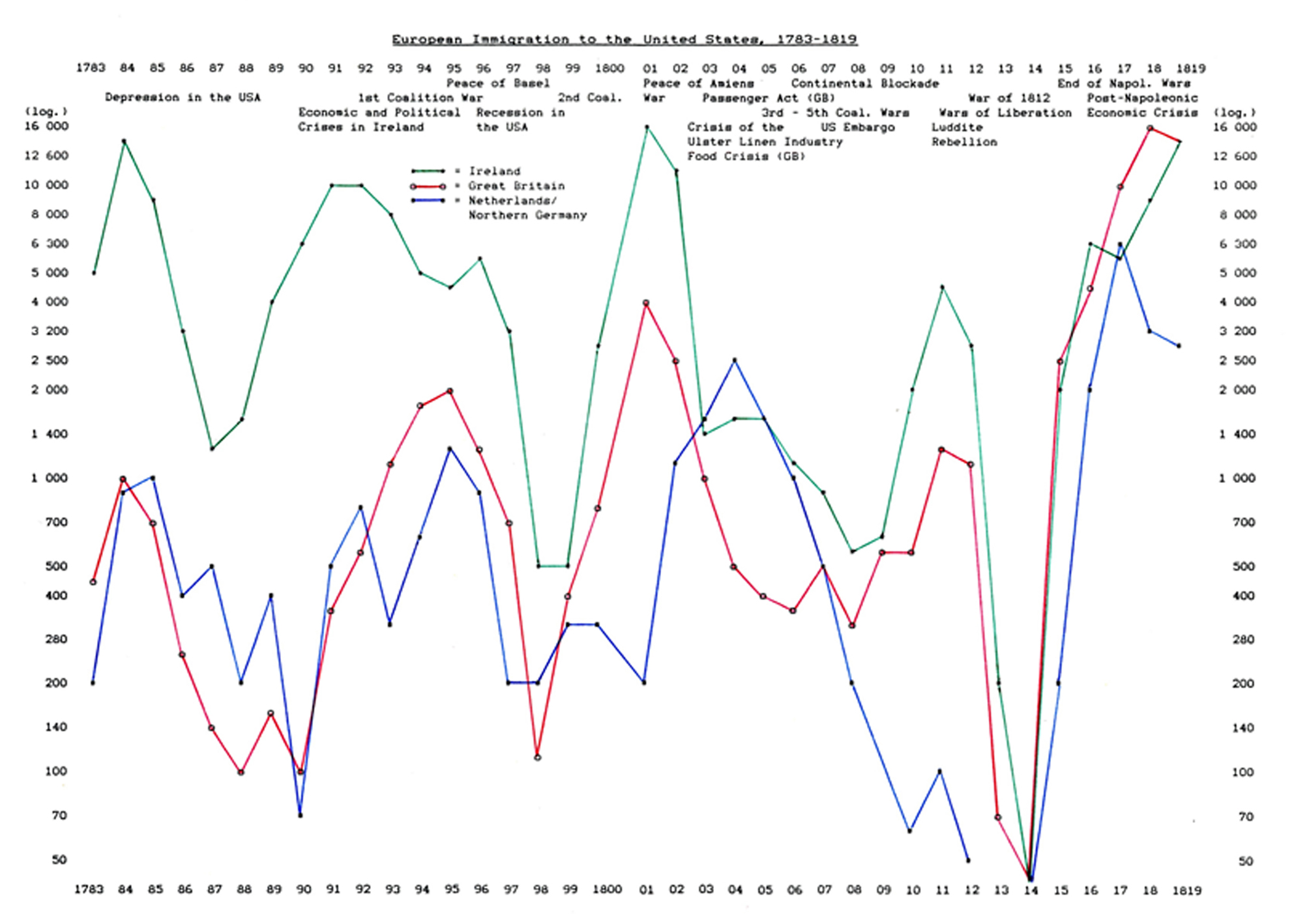
The curves in Illustration 1 are logarithmic and hence exaggerated, but for that very reason they make abundantly clear that in-migration from the European continent, Great Britain, and Ireland was influenced, as one would expect, by economic push and pull factors—the post-revolutionary depression in the United States, the panic of 1796 to 1797, and the panic of 1819—but most of all by the wars in the wake of the French Revolution and during Napoleon’s ascendancy. The Peace of Amiens, concluded in 1802, lasted for only thirteen months, but had an immediate, remarkable effect on Irish and British migration, plus a somewhat staggered one on migration from the continent.
2The much greater decline in British versus Irish migration after 1803 resulted from the British Passenger Act of that year which restricted the number of migrants on a ship. As we shall see, this and two later American passenger acts influenced the passenger trade significantly. When in-migration from German-speaking areas and later from the British Isles came to a standstill from 1812 to 1814, the combined repercussions of the Wars of Liberation against Napoleonic rule and the War of 1812 between the United Kingdom and the United States were to blame. Extreme deflections over a relatively short time span set the years from 1783 to 1819 apart from earlier and later periods characterized by flatter and longer migration amplitudes. 3The graph breaks off in 1819 because immigration from the continent became negligible in 1820 and did not return to significant levels before the 1830s. By then, all the rules that applied to the movement of people from Europe to North America had changed. Contemporaries thought that the explosion of the volcano Mt. Tambora on the island of Sumbawa (in present-day Indonesia) on April 10–11, 1815 was to blame. This had resulted in the proverbial “Year Without a Summer” (1816) in much of Central Europe.[1] Crop failures had caused widespread hunger and led tens of thousands of Swiss and Upper Germans to seek “better luck” in the United States. 4If we look at things from an American vantage point, the effect was less significant. A high number of passengers would have embarked from ports in the Netherlands and Northern Germany after the cessation of hostilities regardless of the volcano’s outbreak. If, however, we look at the total movement of people from the German cantons of Switzerland, Württemberg, Baden, Alsatia, the Bavarian Palatinate, and the three Hessian states, we see a different picture. The state archives of the Kingdom of Württemberg and the Grand Duchy of Baden, for instance, contain hundreds of reports from local officials about destitute families who had either been turned away by ship captains and supercargos in Amsterdam—or who no longer saw the opportunity of a redemptioner passage for these often emaciated people. Furthermore, many would-be emigrants became discouraged on the road to a northwestern port by the sight of destitute returning migrants.[2] The scale of this return migration is still difficult to gauge, but it is possible that thousands never reached the New World.Patterns of Migration
5The majority of migrants from German-speaking areas chose Amsterdam for their voyage to the United States. Hamburg held second place—mostly the result of French control over the Netherlands after 1795, culminating in the incorporation of the Dutch port into the French empire in 1810. When Hamburg became French, too, in February 1811, migrants (and, incidentally, the Hamburg prostitutes) moved north to Tönning, a small port city in the then Danish duchy of Schleswig (Grabbe 150–51, esp. fn. 118).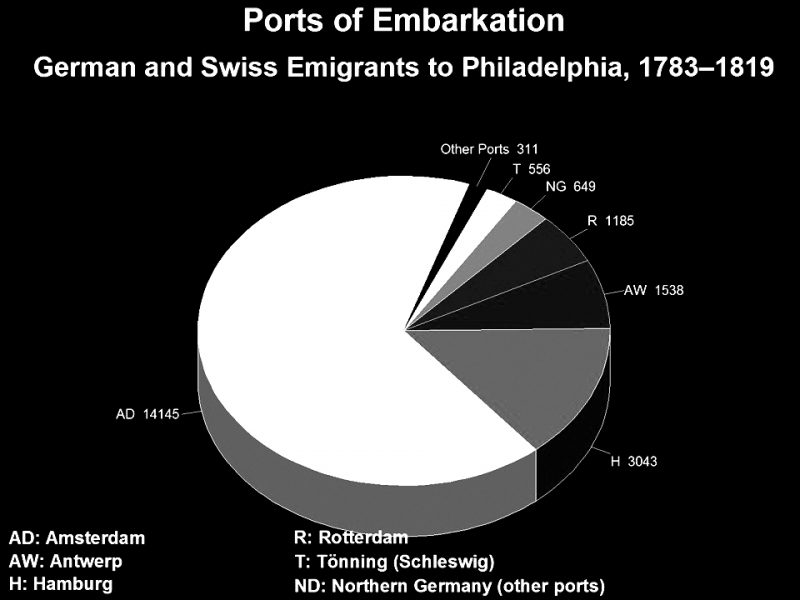
Throughout this period, migrants mostly came from upper Germany and Switzerland and chose the journey down the Rhine to Dutch ports when they could; when they could not, they sidestepped, so to speak, to Northern German ports. On the American side, Philadelphia was the major hub for goods and passengers from the European continent.
6American merchants would export cotton, sugar, coffee, tobacco, or wheat to the European continent, and flax to Ireland. Return cargoes from the Netherlands typically consisted of dry goods and glass wares. For the ships of middling size, operated by smaller merchant firms, a return voyage with bricks or salt in ballast was always a misfortune to be reckoned with. This was the rationale behind carrying servants or redemptioners.[3]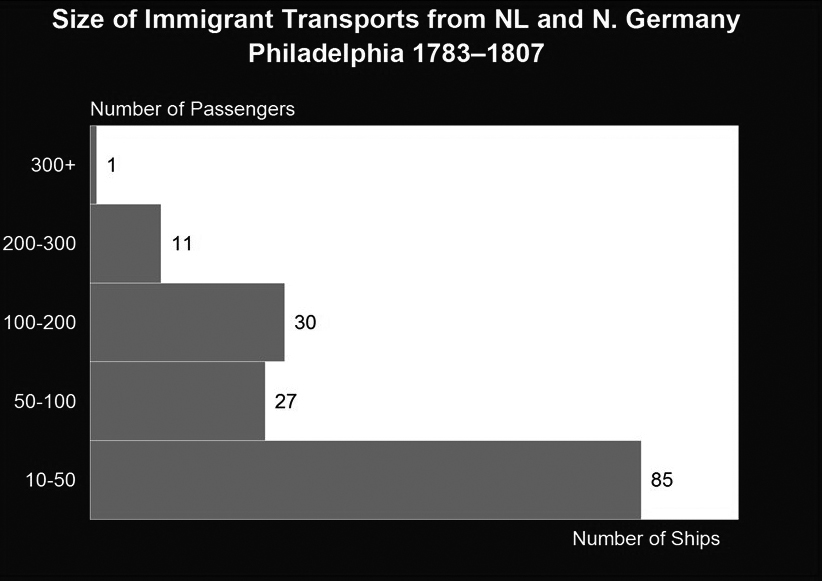
As we can see in Illustration 3, passengers from the Netherlands and Northern Germany often travelled in smaller ships carrying between 10 and 50 passengers. Many of these ships were regular or constant traders which meant that—give or take a few days—they would arrive in Philadelphia in the spring or fall in reliable intervals, thus facilitating the arrangement of servant contracts for the redemptioners on board.
7In May 1802, the ship Devotion, owned by Manuel Eyre, senior partner in one of Philadelphia’s largest merchant firms, lay in the roads near the North Sea port of Den Helder. There was no return freight to be had. Through the sale of the ship, Eyre would have incurred a substantial loss. In this difficult situation, an Amsterdam brokerage firm approached the captain and suggested that redemptioners might make a profitable cargo. Since a complete balance sheet of all expenses and income pertaining to the voyage has survived, chances and risks of the redemptioner trade can be made transparent.[4] 8200 passages would yield 15 guineas each, totaling 3,150 pounds sterling. The cost of provisions, wages, fees, and the conversion of the cargo bays into steerage space suited for passengers was estimated at 7 pounds per head, theoretically resulting in a handsome profit of 1,400 pounds or roughly 6,400 dollars. According to Morgan Freeman’s online Inflation Calculator, this sum would roughly equal 107,000 dollars in today’s money. Unfortunately, the negotiation of servant contracts in Philadelphia, which had begun on October 4, 1802, dragged on until December 10, forcing the Devotion to remain in port at great expense to its owner. The final account was sent by the Amsterdam brokerage firm on August 12, 1803, more than a full year after the Devotion had set sail in Den Helder. The account stated a loss of 2,600 dollars or 43,000 dollars in today’s money. Not that the brokers lacked knowledge of the trade or were of bad repute. Their calculation had been based on past experiences which now appeared to have lost their validity. “We dare say,” they wrote to Manuel Eyre, “not one Expedition of Redemptioners has been made without that the concerned should not have had some Ground for Complaints—but this lies in the Nature of the Business, subject to great Risks & unpleasant Cons” (Grabbe 125). There would always be some vagabonds in a parcel of adventurers, the brokers maintained, but to Manuel Eyre the arrivals in Philadelphia were “wretches picked up in the streets of Amsterdam” (Grabbe 123).The Migration Crisis of 1816–19
9Of the twelve ships with more than two hundred passengers on board arriving in the port of Philadelphia between 1816 and 1819, some had been chartered by religious groups or by emigration societies formed in Switzerland who could provide for themselves. However, most immigrants hoped to pay off their passage by entering into indentured servitude. In a period of only four years, 19 ships with more than 200 passengers arrived, eight ships even carrying well over 400 passengers. None of these ships was associated with a reputable Philadelphia or Amsterdam merchant. Four heretofore unknown consignees imported 3,800 redemptioners in chartered ships.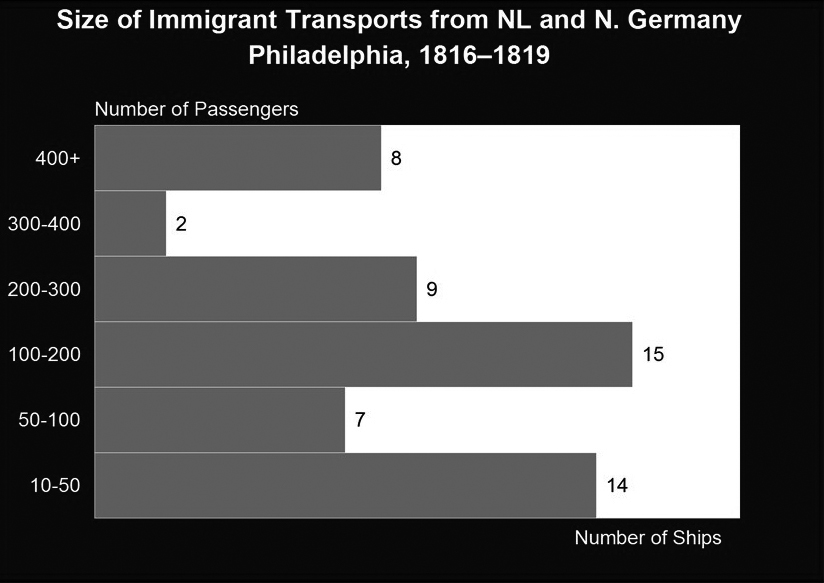
Among the vessels with more than 50 passengers arriving in the port of Philadelphia between 1816 and 1819, 19 were registered in the United States. The other 23 hailed from Dutch, British, Prussian, Swedish, Danish, and even Russian ports. The high demand for passages to the United States in Dutch ports had led to a speculative bubble which facilitated—but did not cause—the demise of the redemptioner system. Some immediate results of the redemptioner surplus may be gleaned from Illustration 5.
10The post-Tambora food crisis had lost some of its force in 1818 and the number of passengers declined slightly, as did the number of people seeking servant contracts.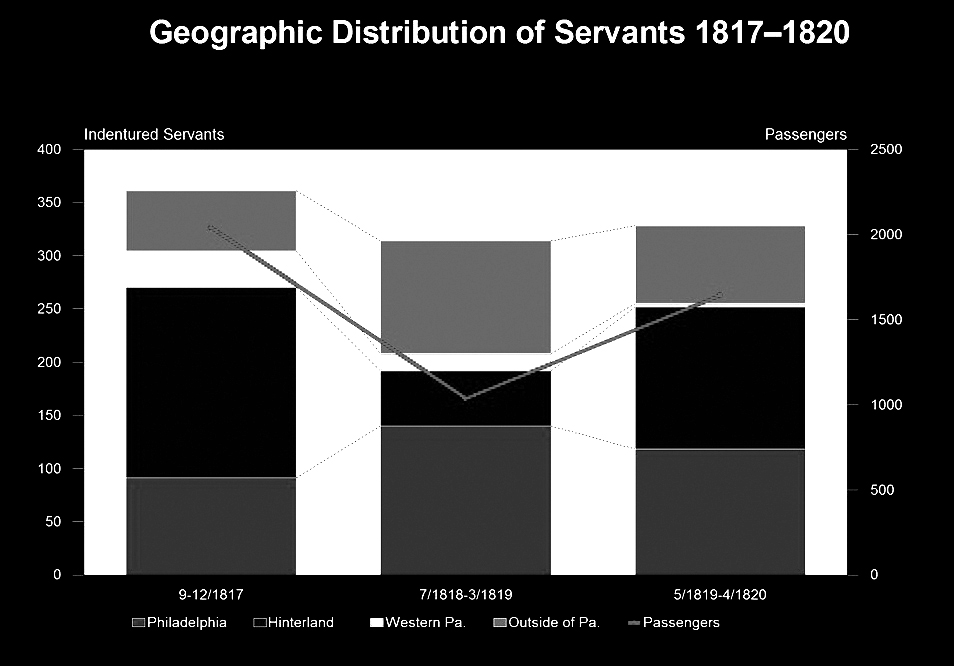
But in 1819, both increased again, only to reach the nadir a year later. Ships originally destined for Philadelphia and Baltimore in 1818 and 1819 were instead directed to New Orleans. In 1820, 621 German passengers arrived in the southern port, compared to only 115 in Philadelphia. Confronted with this sudden influx, the Louisiana House of Representatives passed an act for the relief and protection of redemptioners (Grabbe 251). 500 Germans negotiated servant contracts under this law. Then the practice ceased there, too.
11Let us look once more at Illustration 5: Most redemptioners of 1817 found occupation with farmers or artisans in the counties west of Philadelphia. Smaller numbers were put into servitude in Ohio, Maryland, and southern New Jersey. In 1818, we see an increase in the city of Philadelphia due to a growing demand for household servants, most of them female, but in rural regions the numbers went down significantly. The contracts recorded in the Philadelphia Registry of the Redemptioners during 1818 show that most of the servants were either young unmarried women or minors who became apprentices (Grabbe 346). It should be noted that in 1818 and 1819 the category “Outside of Pennsylvania” refers to the states of New York, Virginia, Tennessee, North Carolina, and even to the Alabama Territory. There is evidence that the importers of redemptioners signed batches of servant contracts themselves, hoping to find better market conditions at a later time. They even reassigned the contracts to soul drivers. The 1819 to 1820 bar looks normal and one would not guess that the last ever indenture in Philadelphia was dated December 9, 1820. It is likely that many of the 300 plus indentured servants of 1819 signed contracts, but never completed their service.Changing Attitudes towards Indentured Servants
12This brings us closer to an understanding of why the redemptioner system ceased to be a valid option for U.S.-bound migrants at that time. The American State Papers of the 16th Congress contain a petition and supporting documents submitted by James Brown, a citizen in Nashville, Tennessee (U.S. Congress, American State Papers).[5] In October 1818, Brown had come to Philadelphia and signed servant contracts with 22 German redemptioners. He planned to travel to Tennessee and Alabama to reassign these indentures there to the highest bidder. The group moved westward on the Cumberland Road to Wheeling. Brown purchased a boat, intending to transport his servants down the Ohio river to Cincinnati. He came as far as Marietta where a hostile, stone-throwing crowd pressured him to set the servants free. Neither the local police nor the militia took action against the mob. 13Brown went away to procure writs of habeas corpus in nearby Virginia only to see himself arrested upon his return to Marietta and escorted back to his boat by the sheriff and a posse of more than one hundred men. A local court then set the servants at liberty, as Brown wrote in an affidavit, “and [they] were congratulated by the court, most of the bar, and nearly all of the spectators.” Brown eventually managed to reobtain six of his servants with the help of a U.S. District Court warrant, but lost them in Cincinnati after German-speaking citizens had physically attacked him and his helpers. In the petition submitted to the U.S. Senate in December 1819, a “change of venue” was demanded. There was “no probability, under the present state of public feeling, that restitution would be made for the injury […] sustained both in person and property. […] Such is the temper and feeling of the people generally that your memorialist believes he would be unable in the State of Ohio to have justice done.” 14It is not possible in this context to go into the particulars of the Ohio constitution, the Fugitive Slave Law and the Mary Clark case decided in 1821 by the Indiana Supreme Court (see Grabbe 363–64). Suffice it to say that Clark, a woman of color, had refused to fulfill her contract of servitude and the court had declared that an act of volition was sufficient to bring her servitude to an end. If the contract were forcibly upheld, it would constitute a humiliation that a free society could not tolerate. Ohio and Indiana were on the verge of becoming the favored destinations of German and Swiss migrants. Their labor markets were ready to absorb many thousands, but the redemptioner system was not an option there. And in Pennsylvania, too, a cultural shift in the attitude towards white servitude became apparent. 15Migrants from the continent, both in the colonial period and after independence came as free agents, intending to negotiate work relationships on American soil. If the immigrants refused to accept servant work relationships offered to them, they became defaulting debtors. This meant that only civil action could be brought against them. Although the debtor’s prison might not have been a pleasant abode, it was certainly an improvement over a berth in the steerage. More importantly, it was the creditor who paid for room and board, hence throwing good money after bad. 16In 1819, 385 Württemberger traveled from Antwerp to Philadelphia under a credit arrangement with private investors. The refused to sign indentures, rendering their promissory notes worthless. The creditors lost 4,000 dollars and were ruined. Other such investors like Ludwig Gall from Trier on the Moselle, and Ferdinand Ernst, the former owner of a large estate near Hannover, had paid the passages of 15 and 94 people, respectively, also in 1819. Upon arrival in Philadelphia, Gall’s prospective servants found themselves surrounded by a group of German Americans who told them they were “free as the air,” because their contracts possessed no validity under U.S. law. The habeas corpus principle preventing an immediate arrest, Gall had to sue for coercive detention before a justice of the peace. There, the amount in dispute was limited to 100 dollars, which meant that at best only a partial recovery of the initial investment was possible. Gall was forced to return to Germany, and Ernst, having lost his assets, became a shopkeeper in Vandalia, Illinois where he died, probably of typhoid fever, in the summer of 1822 (Grabbe 287; Stroble). 17The advice given by the German American bystanders was well-grounded. The Pennsylvania Supreme Court had decided in 1797 that European work contracts were invalid in Pennsylvania, and, in 1811, the same court had clarified that “prepaid servants” must negotiate new contractual agreements upon arrival (Grabbe 337, 287). While the legal basis was not new, the self-confidence of the migrants, most of them young men, had increased, as had the empathy that many Americans felt for debtors. 18After the War of 1812 had ended in March 1815, the United States entered into a period of financial crisis as bank notes rapidly depreciated because of inflation following the war. Then the panic of 1819 led to widespread foreclosures, bank failures, and unemployment. This affected the chances of immigrants to enter the labor market, since the willingness or even ability of potential employers to conclude long-term contracts was greatly reduced. As has been said, the redemptioners of 1818 and 1819 were often under age and parents hoped to apprentice them to artisans so that the financial obligations of their families would be eased. One of the last indentures in the Philadelphia register binds the boy Johannes Wizeman to a baker. The apprenticeship was stipulated to last four years, with six weeks a year reserved for attending school. The baker paid 75 dollars in cash to the boy’s legal guardian (Grabbe 358–59). How many Americans may have been able to pay this much at a time when real wages had fallen by more than 70 percent?Governmental Regulation of the Passenger Trade
19But not only court decisions and laws of supply and demand caused the seminal shift in migration patterns after 1819. Illustration 6 shows the effects of government intervention.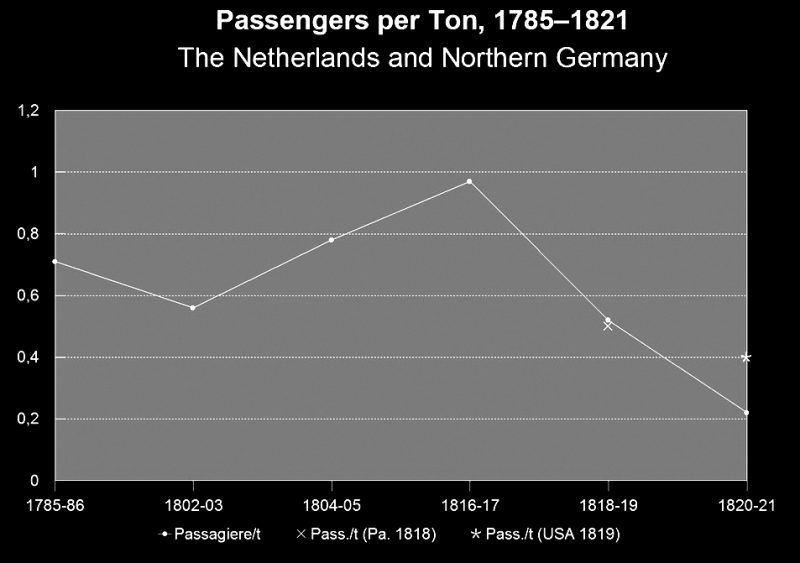
Seen overall, reports of overcrowded ships, high mortality on board, and great suffering were often exaggerated and mostly pertained to a few cases both in the 18th century and during peak levels of early 19th-century migration. The British Passenger Act of 1803 allowed a maximum of one passenger for every five tons of cargo capacity. The resulting relationship of 0.25 to 1 was calculated to end the competition of American vessels on the North Atlantic route and to redirect British and Irish migrants to British North America where a ratio of 0.5 to 1 was to be applied (Grabbe 137–39).
20Ships from the Netherlands and Northern Germany stayed below the 0.5 mark until the migration wave of 1802 to 1803. The average of nearly one passenger per ton in 1816 and 1817 and the deplorable health conditions on several overcrowded ships led to the passage, in January 1818, of the “Act for establishing a Health Office […],” which allowed 0.5 passengers per ton and immediately showed its effectiveness, as can be seen on Illustration 6. Sweeping powers for the city’s health officer and the creation of a quarantine station not only proved beneficial for the health of passengers and city. Violations of the law led to high fines, and this in turn led to a reassessment of risks by ship owners, captains and, brokers (Grabbe 247–48). 21And yet, this laudable effort of the state of Pennsylvania could not prevent the greatest disaster during the 1817–18 season: the voyage of the Dutch ship April (Grabbe 252–54, 371–95). This ship of 300 tons had been filled with up to 1,300 people while in the Texel anchorage, of whom 900 survivors from cholera eventually embarked, and 531 reached the shores of the Delaware river. The April landed in New Castle, Delaware, where captain and supercargo would not be prosecuted. When Congressman Thomas Newton, a Democratic Republican from Virginia, introduced a national “Bill to regulate passenger ships and vessels” on December 16, 1818, he explicitly cited the occurrences on board of the April to explain the rationale behind the new law: “The great object of it was, […] to give those who go and come in passenger vessels a security of sufficient food and convenience” (complete statement printed in Grabbe 394). To that end, the first U.S. law regulating the passenger trade allowed one passenger to every two and a half tons, a ratio of 0.4 to 1. As Illustration 6 makes clear, this goal was achieved immediately. Even higher restrictions by later British and European laws did not lead to further reductions of passenger numbers. Instead, they accelerated the construction of ever-larger ships where small profits per passage added up to high returns per voyage. Migrants were no longer regarded as freights and sailed on vessels dedicated to their needs.New Destinations, Changing Modes of Travel
22The demise of the redemptioner system may also have been influenced by the fact that New York replaced Philadelphia as the largest immigration port in the United States. Its share of total immigration rose from 37.2 percent in 1819 to 70 percent thirty years later. Although the state legislature had passed a law to ease redemptioner imports in 1788, its desired impact was counteracted by New York City’s poverty laws. The 1799 “Act for the better settlement and relief of the poor” targeted Irish, not German, immigrants. It stipulated that captains who landed passengers in New York harbor had to deposit promissory notes of 300 dollars for each passenger—notes that would be drawn if someone became a public charge during the next two years (Grabbe 232–33). The poor law did not prevent the huge influx of destitute foreigners, mostly Irish, into the city, but it cautioned ship owners against importing German redemptioners. 23David Galenson attributes the shift from redemptioner freights to passengers mostly to the falling costs of passage (Galenson). This is addressed in Illustration 7. The data that went into the creation of this graph were costs of passage on individual ships found in archival sources.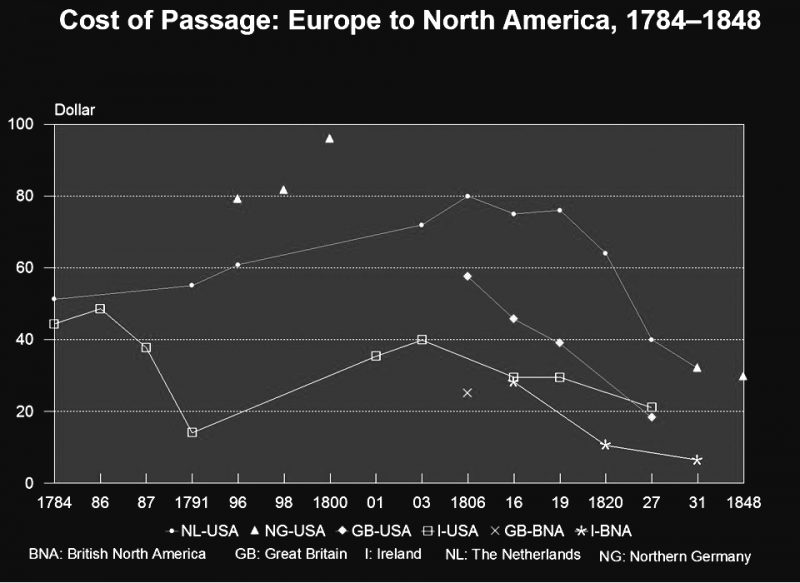
This vouches for reliability but it also explains why we see data lines on some routes and individual markers on others. It is evident that all passage prices fell significantly after 1820. The passage from Northern Germany, which involved the longest voyage, was the costliest. It came down from up to 100 dollars around the year 1800 to 30 dollars in 1848. The cost of passage from the Netherlands dropped to similar levels. Travel from English ports was even cheaper which explains why German migrants of the 1830s often crossed the Channel and travelled to Liverpool as their port of embarkation for the Atlantic voyage. The trip from Ireland to British North America was the least expensive by far. However, since in most cases the migrants did not remain in the British colonies, a coastal voyage from Nova Scotia to Maine or overland travel from Montreal to the Great Lakes region added to the overall expense. But whatever the cost, it had become so much less than in the years up to 1819 that there was no longer an economic necessity for redemptioner travel to the United States. 18th-century-style migration effectively ceased on the North Atlantic route in 1819.
24Already the year before, a New Orleans newspaper had printed a fitting epitaph of the system:That there are many privations and sufferings incident to a voyage of this nature, is undeniable; but from the appearance of those people now in our city, we would not conclude that their case is more than ordinarily so. The servitude they have to submit to here is not of a grievous kind and probably will leave them more vitally free than the political institutions of their own country in their fullest latitude. (Louisiana Gazette, 14 Mar. 1818: 2, qtd. in Grabbe 360)
Notes
[1] Still the best study of the 1816–17 crisis is Günter Moltmann, ed., Aufbruch nach Amerika: Friedrich List und die Auswanderung aus Baden und Württemberg 1816/17. Dokumentation einer sozialen Bewegung, Tübingen: Wunderlich, 1979.
[2] See the thorough interdisciplinary study by Stefan Brönnimann and Daniel Krämer, “Tambora and the ‘Year Without a Summer’ of 1816: A Perspective on Earth and Human Systems Science,” Geographica Bernensia G90 (2016), DOI: 10.4480/GB2016.G90.01.
[3] Even after the American Revolution, immigrants from Ireland often came as servants whose contracts had been negotiated in Europe. This was against the law, but seems to have been tolerated by the American authorities up to the 1790s. German and Swiss emigrants who mostly went to Pennsylvania and Maryland, entered the U.S. as free agents and negotiated redemptioner contracts, which meant that the credited cost of passage was redeemed by their would-be masters. They became indentured servants for a number of years and received so-called freedom dues (money, clothes, tools) after the term of service was over.
[4] The voyage of the ship Devotion is extensively documented in Grabbe 116–26.
[5] A facsimile is available on the American Memory website of the Library of Congress.
Works Cited
Galenson, David W. “The Rise and Fall of Indentured Servitude in the Americas: An Economic Analysis.” Journal of Economic History 44.1 (1984): 1–25. Print.
Grabbe, Hans-Jürgen. Vor der großen Flut: Die europäische Migration in die Vereinigten Staaten von Amerika 1783–1820. USA-Studien 10. Stuttgart: Steiner, 2001. Print.
Stroble, Paul E. “Ferdinand Ernst and the German Colony at Vandalia, Illinois.” Illinois Periodicals Online. Web. 17 June 2017.
U.S. Congress, American State Papers: Documents, Legislative and Executive of the Congress of the United States [1789–1838], Cl. X, Misc., vol. 2 (Washington: Gales & Seaton), 1834: 550–54.
Author
Hans-Jürgen Grabbe, Professor Emeritus of British and American Studies at Martin Luther University Halle-Wittenberg, is the general editor of the American Studies Journal. A former president of the German Association for American Studies and the European Association for American Studies, he is an editor of the quarterly Amerikastudien/American Studies and also serves as editor, on behalf of the EAAS, of the book series European Views of the United States. Much of his research has been focused on transatlantic migration in the 18th and early 19th centuries.
Suggested Citation

This work is licensed under a Creative Commons Attribution-ShareAlike 3.0 Unported License.


 orcid.org/0000-0002-3316-7654
orcid.org/0000-0002-3316-7654